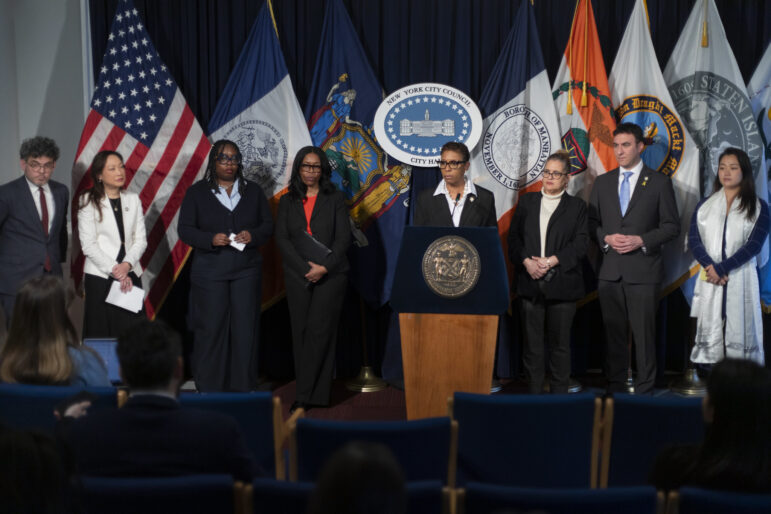When Lewis arrived in New York a year and a half ago, he thought he’d finally reached safety.
He had escaped months of detention and death threats in his home country, Liberia, where he had been arrested by government officials. They accused him of inciting a riot because he organized a campus fundraiser to help pay poor students’ tuition. Lewis recounts how members of the Special Operation Division, a state security agency notorious for committing human rights violations, made him kneel on broken stones as they questioned him. They burned him with candle wax and cigarettes, and lashed him with a cable wire until he passed out.
Lewis got released, but only with the help of a friend who worked with the Special Operation Division. Soon he was arrested again, after demonstrating for free speech and the right to criticize the government. This time, he was imprisoned at a police academy, where he was kicked and beaten. After four days, he managed to escape. Too frightened to return to his home, which had been ransacked, he stayed with friends.
His third arrest came a week later, when he was handcuffed and put in the back of a van by Special Operation Division officers, then mysteriously released on the side of the road. A couple of days later, he was warned that his name was on a government death list. So Lewis turned to a friend’s relative, who pulled together money for a ticket to the U.S. and arranged for him to bypass officials at the Monrovia airport.
His flight brought him to John F. Kennedy International Airport. There, Lewis–who is afraid to have his full name published–walked to the immigration officials booth and told them he had no visa to enter the United States. That started him on a path to political asylum–and a whole new ordeal of mistreatment by officials at JFK.
Lewis told the inspectors he’d come to the U.S. because he needed “protection.” In what’s known as “primary inspection,” a person can qualify for consideration as an asylee simply by implying–in general terms–that he or she is afraid to go home. It’s not necessary to explain the reason for the fear right away.
So far so good. Lewis was then taken to a large room with other asylum-seekers, for what the feds term “secondary inspection”–a special evaluation of immigrants without proper paperwork and people asking for asylum.
To Lewis’ surprise, officers in this room chained his hands and feet together. When his name was called, he shuffled to a counter. To see if he was really from Liberia, he was asked to name the tallest mountain and the most widely spoken languages in his country.
He passed that test, but the immigration officers then detained him for a day and a half, in a room with no place to sleep, all the while in shackles. After that, he was taken to a smaller room and ordered to prove he’d been tortured by stripping naked and showing his scars. He did, and the officials mocked the appearance of his buttocks.
It was like being in Monrovia all over again. Lewis was humiliated, angry and afraid. Still, he went along with everything the officers demanded because, he says, “I thought they were doing their job.”
On that count, Lewis was dead wrong, say immigration lawyers and advocates. The officials stepped outside their legal bounds, says Reena Arya, Lewis’ attorney.
Arya, who works for the New York-based nonprofit legal group Hebrew Immigrant Aid Society, is outraged that Lewis was ordered to strip. She’s also angry that he was asked to detail his claims of repression, which are not supposed to be discussed during secondary inspections. She points to the INS Inspections Field Manual, which forbids the practice; that questioning is supposed to be done by a qualified agency officer during a formal hearing.
_______
Lewis’ case appears to be hardly exceptional. Arya and many other immigration lawyers say clients routinely report that they were asked inappropriate questions and treated improperly, sometimes appallingly. “At JFK there have been a lot of complaints,” says Archi Pyati, an attorney with the Asylum Project at the New York-based organization Human Rights First (formerly the Lawyers Committee for Human Rights). She has heard reports of people withdrawing their asylum petitions because they were intimidated, sometimes by the first official they encountered while presenting their passport and papers. Clients have recounted being told they’d be thrown in a U.S. jail if they didn’t drop their claim and go back to their country. Further, Pyati says, being screened in secondary inspection (where Lewis was ordered to strip) now takes much longer than it used to. New arrivals are detained for up to 48 hours and aren’t always permitted to lie down, use the bathroom or eat enough food to stave off hunger.
“People who are really, really afraid might be so intimidated that they get back on the plane,” says Pyati. “That’s a breakdown of the refugee process and a clear violation of international law,” she notes, citing the Geneva Convention as authority.
So why is the U.S. apparently violating the Geneva accords? Pyati lays part of the blame on a procedure called “expedited removal.” The phrase describes a seven-year-old immigration policy for people whose first contact with immigration officials is at borders and airports.
During 2002, the last year for which statistics are available, about 58,000 immigrants asked for asylum in the U.S. Most were smuggled into the U.S. or came legally on tourist visas, then stayed after the visas expired. These asylum petitioners generally were not imprisoned and could continue living in the U.S. while waiting for their asylum hearings.
But among these people there were also roughly 10,000, including Lewis, who applied for asylum at border ports of entry or (more commonly) airports–usually JFK or Newark. Though they’re far from Canada or Mexico, the federal government classifies airports as “functional equivalents” of the U.S. border. And when people ask for asylum at a border, they don’t have the right to post bond, set a court date for months in the future and hop a cab to a cousin’s house.
Instead, they are immediately placed in “expedited removal” proceedings. They can be deported on the spot, or imprisoned until their case is decided. Getting locked up can make it hard for an immigrant to find a lawyer, or to help an attorney build an asylum case. Meanwhile, the policy at airports puts unprecedented power in the hands of inexperienced officials, who may act abusively toward asylum applicants or wrongly return them to their countries.
It was not always this way. But during the 1980s and 1990s, public fear that undocumented immigration was increasing grew, fanned by an influx in the 1980s of Guatemalans and Salvadorans fleeing civil wars. Though many of these immigrants were political refugees, most were denied asylum because the U.S. supported their governments in the domestic conflicts. Many of these immigrants, and those from other countries as well, applied for asylum.
The judges who heard these cases usually had years of experience dealing with asylum applicants and their stories of repression, and they were the only people authorized to make decisions about deportation. Their courtrooms were not located at bridges or airports, and hearings usually took place months after they were scheduled. Meanwhile, applicants could post bond and live in the U.S. while they were awaiting a decision.
But many asylum-seekers never showed up to their hearings. The government worried about losing track of these absconders, as well as about growing numbers of undocumented immigrants. So when Congress overhauled immigration policy in 1996, it gave INS inspectors authority to decide about deportation right at the border or the airport–and their decisions weren’t subject to review.
Since then, the process has only become less accountable. Now, Department of Homeland Security Customs and Border Protection officers can make snap judgments about deportation, right in the airport.
Often, they have little or no experience in asylum issues. Customs inspectors, Department of Agriculture personnel and border patrol agents are experts in ferreting out contraband and asking people for their papers. But they are not used to dealing with traumatized foreigners who are fleeing persecution and can’t speak English well. The result, say lawyers and advocates, is that asylum-seekers often get mistreated, and there’s nothing to ensure that officers aren’t sending people who are fleeing repression back to prison and death. What happens in the back rooms at U.S. airports remains largely a secret to lawyers and the media.
The Department of Homeland Security denies there’s a problem, and chalks up bad experiences to unavoidable delays caused by the war on terrorism. Take the long waits that asylum-seekers–including Lewis–say they’ve endured while being interrogated. Homeland Security spokesperson Bill Strassburger calls these lengthy detentions unusual, but says stricter questioning is needed because of heightened security concerns since 9/11. He also says that the immigration, customs and agricultural inspectors who question asylum-seekers have received training to carry out their new task.
In any case, says Strassburger, Homeland Security encourages people who feel they’ve been mistreated to file a complaint. “We don’t want to see anything being done wrong, especially to a person fleeing persecution,” he says. “They’ve already suffered enough.”
But immigration lawyers and advocates have trouble filing complaints, because the secrecy of expedited removal keeps them from adequately documenting clients’ claims of mistreatment. And they’ve been frustrated by the response they’ve gotten.
Early last year, for example, Lewis’ lawyer, Arya, wrote the New York INS district director protesting Lewis’ treatment. She cited the INS Inspections Field Manual, which forbids officials from asking detailed questions about an applicant’s fears during the early part of the asylum petition process. Yet Lewis clearly had endured just this sort of questioning–and it had been documented. “This time we had it on paper,” Arya says. She also had a transcript showing that officials had examined her client’s body.
When asked about the body exam, Strassburger agreed that it sounded inappropriate. But the answer Arya received to her complaint did not sound very concerned. In response to her letter about how Lewis was questioned, Port Director John Mirandona replied that “this office does not find those queries to have been excessive.” He didn’t mention the body exam.
_______
After expedited removal went into effect in 1997, there were so many complaints of mistreatment that a year later Congress instructed its General Accounting Office to examine the process. The GAO was told to investigate whether INS officers encouraged asylum-seekers to withdraw their applications, failed to refer them to interviews where experts determine if their fears sound believable, sent them to countries where they could be persecuted, improperly detained them or held them under inappropriate conditions.
But in its report, released in 2000, the GAO did not address these questions directly. Instead, the agency later said it lacked the expertise needed to evaluate INS inspectors’ decisions. Further, the GAO has told government subcommittees and advocacy agencies that it would have been too expensive to probe whether officers were improperly encouraging asylum-seekers to withdraw their applications. Instead of checking into that possibility, investigators looked mostly at whether INS employees at airports did the right paperwork on asylum applicants. The conclusion was that they had.
A month later, another study sharply criticized the GAO for relying entirely on self-reporting by the INS. Published by the Center for Human Rights and International Justice at the University of California’s Hastings College of the Law, the study further noted that the feds failed to watch agents as they worked, or to review complaints from people who help asylum-seekers.
Then, last fall, the United Nations’ high commissioner on refugees took a look at the expedited removal process, as part of a study for the Department of Homeland Security. Though the report has not yet been made public, a November UN press release said the study found that inspectors usually did a good job identifying possible asylum claims and referring them to asylum officers. Still, several things troubled the commission, including the use of restraints. Shackles, like the ones put on Lewis were routinely used on asylum-seekers at one unnamed airport. Restraints, the commission noted, could re-traumatize people who have already suffered persecution. And researchers observed inappropriate questioning–supporting lawyers’ complaints about asylum-seekers being intimidated.
The UN also criticized the government’s interpreting services during interviews, calling them shoddy. Arya notes that asylum-seekers she deals with have often been forced to answer questions in a language they don’t know well. For example, another Liberian client, a woman from a rural area, was interrogated in English, which she barely spoke. Her transcript, which she signed with a thumbprint because she is illiterate, said she was seeking asylum because she was leaving her husband. What it should have said was that she was coming to the U.S. to be with her husband, who had already fled Liberia. Later, after her proceedings were conducted in her native Mandingo, she was granted asylum–but only after Arya convinced officials that government interviewers had made a translation error. Mistakes like this, the UN commission warned, can follow asylum petitioners into hearings and hurt their cases.
A fourth study, soon to be made public, intends to be the first with eyewitness accounts of the asylum application process and first-hand descriptions from refugees. Scheduled for release in September, the report is authored by the U.S. Commission on International Religious Freedom, which Congress established under the 1998 International Religious Freedom Act. Commission lawyer Mark Hetfield and three outside experts have been negotiating with the Department of Homeland Security to gain entrance to the secondary screening rooms–where most contact between deportation authorities and asylum-seekers happens. Hatfield says the religious-freedom researchers will talk to asylum-seekers as well as government officials.
Some immigration lawyers suspect that with a team hovering over them with clipboards, federal agents will be on their best behavior. But other advocates hope the commission will uncover the rampant violations of procedure that asylum-seekers have described.
Lewis’ asylum claim was eventually deemed legitimate while he was at JFK, even though officials noted in his records that his body had no scars to verify his stories of torture. (His attorney later had a physician examine him; the doctor testified that Lewis did have scars consistent with his account, including a large, square-shaped one that protrudes a half-inch from his chest.)
Like most asylum-seekers coming through New York, Lewis was transferred to a detention center in Queens run by the Wackenhut Corporation–a boxy, windowless government-contract facility near the airport. After spending about a week there, he passed an initial interview to substantiate that his fears about returning to Liberia sounded serious enough to merit a hearing with an asylum officer. After that hearing, he had a final audience before an immigration judge. Lewis was granted asylum last year.
Though traumatized by his treatment at JFK, he is putting the memory behind him. Today, Lewis studies nursing, works as a nurse’s aide and lives with his fiancée in a modest apartment in suburban Connecticut. He is connected to a small circle of Liberians who are happy to find palm butter, cassava leaf and fu-fu in Connecticut. Even so, they celebrated last Thanksgiving with something Lewis had never eaten in Monrovia: a turkey.
New York-based freelance writer Elizabeth Amon is a Soros Justice Media Fellow with the Open Society Institute.







